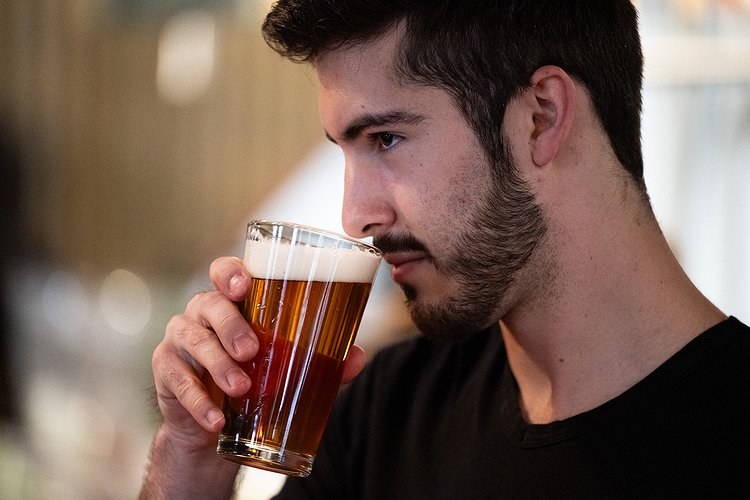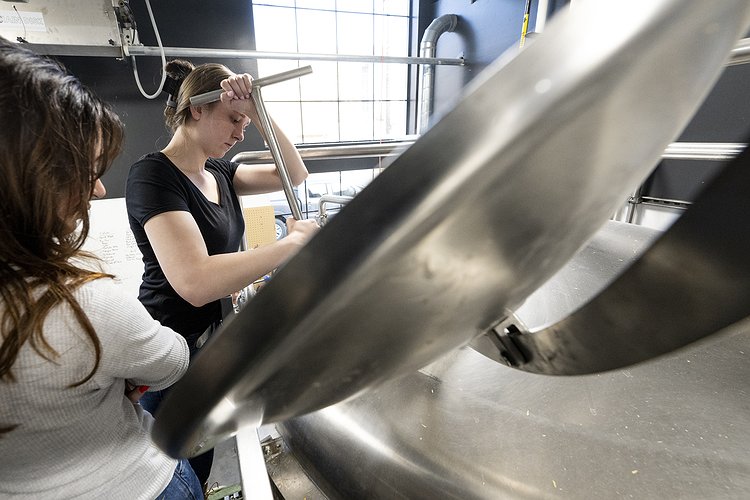Bottoms Up: UM course teaches students beer brewing
MISSOULA – It’s typically not condoned for University of Montana students to skip classes to sample beer at 9 a.m., but there they were on a recent weekday morning sipping an IPA at Missoula’s Draught Works brewery.
Lest you think of them as slackers, know this gathering wasn’t focused on frivolity but on the very serious business of beverage quality – characteristics like color, taste and foam … er head. It was, in other words, a part of their studies.
The students, all enrolled in the UM’s Brewing Science program, had already spent hours in the classroom learning about the nitty gritty of beer making and on this morning were diving into their end-of-semester project — brewing 15 barrels or so of a New Zealand-style IPA. A similar gathering of students from the class met earlier in the week at Conflux Taphouse to fashion another version of the light-colored ale.
“We worked with both breweries and thought this would be a nice style and would sell well,” said class instructor and chemistry Professor Chris Palmer. “It should be up on the board later this spring.”
Palmer, who lends his chemical analysis expertise to breweries across town, launched the brewing program three years ago after first taking a sabbatical to study at Oregon State University’s research brewery. Developing a brew curriculum at UM made perfect sense, he said, particularly when you consider that Montana farmers are known for producing some of the finest malt barley in the country and that Missoula has two of the largest craft breweries in the state, in addition to consistently ranking among the top craft brew cities in the country.
“This really is such an important industry for Montana,” Palmer said. “Our ultimate goal is to prepare people who are career ready, should they choose, to work in all facets of brewing.”
For program graduate Hunter Rock-Merrick that facet is working as the laboratory technician for Draught Works, providing quality assurance and control or “what to do to a batch and when,” as he explained.
“The brewers in town really appreciate that UM has this program,” said Rock-Merrick, whose girlfriend also graduated from the program and worked for a time at Big Sky Brewing.
UM offers both a certificate and certificate of applied science in brewing science, with “science” being the operative word. Requirements for the certificate are a bit less stout than the CAS, but both require completion of courses in general chemistry, organic and biochemistry, and basic biology.
“The fun thing about the class is that it’s a whole new way for students to learn chemistry and biochemistry,” Palmer said. “But it’s definitely a university-level course.”
Among the many points learned are how to achieve proper pH and sugar levels, assessing the alcohol content of a brew, the various types of malts and hops, and the importance of keeping tanks and equipment not just clean, but very clean.
“There was definitely more chemistry and science than I expected to be in beer,” said Christopher Maples, a student in the class who is from Palo Cedro, California. “But Dr. Palmer brings such a passion to the subject, and he breaks it down and makes it very approachable.”
Maples, who studies biology with an emphasis on human biology and wants to become a veterinarian, had one time thought about being a chef. A better understanding of beers as a complement to a meal fueled his interest in learning more about the brewing process.
“I’ve been most surprised by how much the quality of water plays into beers,” he said. “I used to think it was climate related. Dark ales in Scotland; light ale in Mexico. But in many instances, before we could use additives as we do now, it was the minerals and other ingredients in the water that dictated the beer style.”
Class student Nathaniel Milton studies pharmacy at UM and enrolled in the brewing class after hearing about it from a former roommate.
“It sounded like a fun way to learn more about chemistry,” said Milton, who’s from Salt Lake City. “It’s been very in depth, and there is so much involved … the different kinds of grains and where they come from and the types of barley.
“I am not going to work for a brewer, of course, but home brewing as a hobby is definitely in the future,” he added.
Palmer said it’s not a requirement to be a legal drinking age to take the course, but students who are not 21 can’t sample the class project. For Maddie Madden, age 20 years and 6 months, that meant drinking a latte at the Draught Works class gathering. She takes her predicament in good humor.
“It’s not that weird for me,” she said. “I’ve taken a lot of chemistry and this looked super interesting, and Dr. Palmer said he was fine with me signing up for the class as long as I didn’t sample any of the products.”
Madden, a prepharmacy student who grew up in Plains, found the process for counting yeast cells in a brew batch particularly interesting.
“They use a microscope to make sure there is an adequate amount of yeast,” she said.
Someday, Madden hopes she and her father, who shares in interest in brewing, can open a small brewery where her parents now live in Alaska, but until then they will try their hand at home brewing.
“It will be a cool thing to do with my dad,” she said.
Program alumnus Lars Ponsness, a first-year medical student at the University of Washington, spent a year after graduating with a UM biochemistry degree working as a brewer at Big Sky Brewing.
“During my interviews with medical schools, everyone wanted to talk beer and what my favorite style was,” he recalled with a chuckle. “Moose Drool came up a lot and Cold Smoke.”
Ponsness said the brewing course appealed to him because it provided an opportunity to put science to an application — something other fields of study such as in the arts and creative writing do as a matter of course.
“This course really is important to Montana,” he added. “It elevates the quality of all the breweries in the state. It’s important that UM is involved.”
For videos and more photos about UM’s beer curriculum, visit https://bit.ly/UMbeer.





